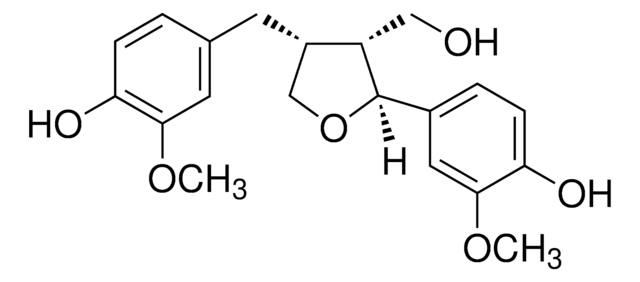Products may be shipped at a different temperature than the recommended long-term storage temperature. If the product quality is sensitive to short-term exposure to conditions other than the recommended long-term storage, it will be shipped on wet or dry-ice. If the product quality is NOT affected by short-term exposure to conditions other than the recommended long-term storage, it will be shipped at ambient temperature. As shipping routes are configured for minimum transit times, shipping at ambient temperature helps control shipping costs for our customers. For more information, please refer to the Storage and Transport Conditions document: https://www.sigmaaldrich.com/deepweb/assets/sigmaaldrich/marketing/global/documents/316/622/storage-transport-conditions-mk.pdf
223735
Coniferyl alcohol
98%
Sinónimos:
3-(4-Hydroxy-3-methoxyphenyl)-2-propen-1-ol, 4-Hydroxy-3-methoxycinnamyl alcohol
About This Item
Productos recomendados
Nivel de calidad
Ensayo
98%
Formulario
solid
bp
163-165 °C/3 mmHg (lit.)
mp
75-80 °C (lit.)
solubilidad
alcohol: moderately soluble(lit.)
diethyl ether: freely soluble(lit.)
water: insoluble (almost)
grupo funcional
hydroxyl
temp. de almacenamiento
−20°C
cadena SMILES
COc1cc(\C=C\CO)ccc1O
InChI
1S/C10H12O3/c1-13-10-7-8(3-2-6-11)4-5-9(10)12/h2-5,7,11-12H,6H2,1H3/b3-2+
Clave InChI
JMFRWRFFLBVWSI-NSCUHMNNSA-N
¿Está buscando productos similares? Visita Guía de comparación de productos
Categorías relacionadas
Código de clase de almacenamiento
11 - Combustible Solids
Clase de riesgo para el agua (WGK)
WGK 3
Equipo de protección personal
Eyeshields, Gloves, type N95 (US)
Elija entre una de las versiones más recientes:
¿Ya tiene este producto?
Encuentre la documentación para los productos que ha comprado recientemente en la Biblioteca de documentos.
Los clientes también vieron
-
How is shipping temperature determined? And how is it related to the product storage temperature?
1 answer-
Helpful?
-
-
How can I determine the shelf life / expiration / retest date of this product?
1 answer-
If this product has an expiration or retest date, it will be shown on the Certificate of Analysis (COA, CofA). If there is no retest or expiration date listed on the product's COA, we do not have suitable stability data to determine a shelf life. For these products, the only date on the COA will be the release date; a retest, expiration, or use-by-date will not be displayed.
For all products, we recommend handling per defined conditions as printed in our product literature and website product descriptions. We recommend that products should be routinely inspected by customers to ensure they perform as expected.
For products without retest or expiration dates, our standard warranty of 1 year from the date of shipment is applicable.
For more information, please refer to the Product Dating Information document: https://www.sigmaaldrich.com/deepweb/assets/sigmaaldrich/marketing/global/documents/449/386/product-dating-information-mk.pdfHelpful?
-
Active Filters
Nuestro equipo de científicos tiene experiencia en todas las áreas de investigación: Ciencias de la vida, Ciencia de los materiales, Síntesis química, Cromatografía, Analítica y muchas otras.
Póngase en contacto con el Servicio técnico













